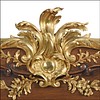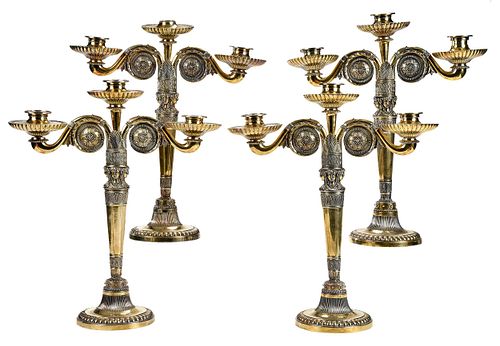The Earl of Granville Ambassadorial Set of George III Gilt English Silver Three Light Candelabra
Bid Increments
| Price | Bid Increment |
|---|---|
| $0 | $25 |
| $100 | $50 |
| $1,000 | $100 |
| $2,000 | $200 |
| $3,000 | $250 |
| $5,000 | $500 |
| $10,000 | $1,000 |
| $20,000 | $2,000 |
| $50,000 | $5,000 |
| $100,000 | $10,000 |
London, 1804, two arm candelabra, egg and dart, basket weave, foliage and floral decoration, tapering post with Egyptian mask at top and ending with feet, lobed sconces and bases engraved with the Royal badge and the Leveson-Gower crest, marks for Digby Scott and Benjamin Smith, base inscribed "RUNDELL BRIDGE ET RUNDELL AURFICES REGIS...ET PRINCIPIS WALLIAE LONDINI FECERUNT", .925 fine, 307.67 oz. T., each approx. 16-1/2 x 14-1/2 x 5-1/4 in.
Provenance: Supplied by the Jewel House in 1804 to Granville Leveson-Gower, later 1st Earl Granville, to his son; Granville, 2nd Earl Granville, by descent to; Granville, 5th Earl Granville (succeeded 1953), sold Sotheby’s, London, 2 June 1977, lot 76; Donated in the 1980s to an East Coast Institution
Sotheby's Note: These candelabra formed part of the Ambassadorial plate supplied to Granville Leveson-Gower for his embassy to St. Petersburg in 1804-05.
Granville Leveson-Gower (1773-1846), later 1st Earl Granville, was the second son of Granville, 1st Marquess of Stafford, by Lady Susanna Steward, daughter of the 6th Earl of Galloway. His father was a major Whig politician, and in 1799 theirs was considered the fifth-wealthiest family in the country, particularly from mining and canal tolls. The son attended Christ Church, Oxford, until 1789, then was elected M.P. for Litchfield 1795-99, and for Staffordshire 1799-1815 (thus during his embassies to Russia). He was sent as Ambassador to congratulate King Frederick William of Prussia on his accession in 1798, and served as a Lord of the Treasury 1800-1801, and as a Privy Councilor in 1804.
Granville was a celebrated male beauty of his era, compared by Prime Minister William Pitt to Hadrian’s Antinous but described by other contemporaries as having “too much of a fair, soft, sweet sort of beauty” (The Peerage). In 1794 he met in Naples the unhappily married Henrietta Ponsonby, Countess of Bessborough, daughter of John, 1st Earl Spencer, and sister of Georgiana, Duchess of Devonshire. Lady Bessborough would later say that she “loved him to idolatry for seventeen years,” and she had four children by him. Granville was not particular in his favors and had a reputation as a lady-killer; after he dropped Lady Hester Stanhope in 1804 – probably while she was pregnant with his child – the lady attempted suicide.
Lord Granville was appointed Ambassador to St. Petersburg in July 1804, under William Pitt the Younger. As Ambassador, he would have received an extensive allowance of plate from the Jewel House, of which these candlesticks would have been part. Other elements of his ambassadorial service were also retained by the family until the 1977 sale, including four vegetable dishes and covers by Scott and Smith (resold Christie’s, London, 30 November 2006, lot 640), four salvers, and flatware. A set of three sauce tureens by Scott and Smith from the service was sold Sotheby’s, New York, 21 October 1998, lot 49.
He did not leave London for St. Petersburg until October, 1804. As there was not a permanent embassy, Lord Granville probably leased a residence on the English Embankment, near the Admiralty and St. Isaac’s Cathedral, the traditional area for the British representative. His was not an easy diplomatic task; Tsar Alexander I had succeeded on the assassination of Paul 1 in 1801, a plot which supposedly had the support of the then British ambassador. Alexander broke his father’s alliance with Napoleon and ended Russia’s war with Britain. However, the Tsar would change Russia’s position towards France four times between 1804 and 1812. Granville was initially successful, and in 1805 Alexander joined Britain in the War of the Third Coalition against Napoleon, but was defeated with the Austrians at Austerlitz (2 December 1805).
Granville was replaced as Ambassador in 1806, but was again sent to Russia in April 1807. This time, the climate was much less welcoming. After the Russians were defeated again by the French at the Battle of Friedland (14 June 1807), Alexander and Napoleon signed the Treaty of Tilsit on June 25, 1807, making themselves allies. Diplomatic relations were suspended between Russia and Britain, and Granville returned home.
In London, he served as Secretary at War and a Member of the Cabinet in 1809. That same year, Henrietta Bessborough helped arrange her lover’s marriage with her own niece, Harriet Elizabeth (b. 1785), daughter of the 5th Duke of Devonshire and Georgina. Surprisingly given its origin, it would be a happy marriage and the couple would have five children.
In 1815 Lord Granville was created Viscount Granville of Stone Park, and in 1823 he was named Ambassador to the Hague. The following year he was named Ambassador to France, a position he (and Harriet) would fill from 1824 to 1828, from 1830 to 1835, and again from 1835 to 1841. Despite occasional waves of Anglophobia in French politics, they were a very popular and successful couple. Their renovation of the embassy on the rue du Faubourg Saint-Honoré, including adding a conservatory, was much admired, and it became a social center of Paris. Canning’s letters to the Ambassador reveal him to be occasionally careless and problematic, but it was evidently felt that his other skills outweighed these lapses.
The couple retired after Granville had a stroke, leaving Paris in 1841. In 1833 he had been created 1st Earl Granville, the same year his older half-brother was created Duke of Sutherland. The Earl died in 1846; his Countess survived until 1862, remembering her husband “adored Granville, who could make a barren desert smile.
Condition
two arms and two nozzle unmarked; missing one nozzle; one with bent column and small dent in base; one central post with striped threads; one central scone split and repaired at base; one with large dent in base, all light loss to gilt, typical wear, crisp details and marks clear
Available payment options
Purchased items will be available for pick up or shipping from our Asheville, North Carolina auction facility within ten business days of the auction will be assessed a storage fee of $5.00 per day, per item. Purchaser agrees that packing and shipping is done at the purchaser's risk and that the purchaser will pay in advance all packing expenses, materials, carrier fees and insurance charges. At our discretion, items will either be packed by an agent such as a packaging store or Brunk Auctions. Please allow two weeks for shipping after payment is received. Shipment of large items is the responsibility of the purchaser. We are happy to provide names of carriers and shippers if a purchaser so requests. Brunk Auctions will have no liability for any loss or damage to shipped items.
Supplied by the Jewel House in 1804 to Granville Leveson-Gower, later 1st Earl Granville, to his son; Granville, 2nd Earl Granville, by descent to; Granville, 5th Earl Granville (succeeded 1953), sold Sotheby’s, London, 2 June 1977, lot 76; Donated in the 1980s to an East Coast Institution


































